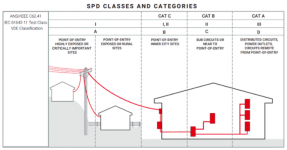PS: Also, some of the semiconductor devices in the modern appliances will blow below the MOVs voltage knee.
Had lightning strike son's house via a nearby tree, tree arced to house to AC feeder. Had small movs at the AC which did not get damaged, yet a couple of FETs in the AC blew.
Only way to protect against that is semiconductor limiters and LC filters or isolation transformer, large and $$$
This demonstrates one of the issues with your design.
You are using components which are not Listed. That’s a huge Code problem. Worse you are using only the MOV. Are you aware of what happens when the MOV fails? It turns into a dead short. That is why Listed assemblies must be fused. You are just being cheap in all the wrong ways.
The lead length is important to be sure but the MCOV on those commercial devices is at the end of the pigtails. That’s how UL tests them. So your concern is valid but lacking interpretation.
Finally you apparently grasp the concept of lead length but remember a MOV is in parallel with the equipment protected along with the leads. So the range you are talking about has some seriously long leads from the MOV and all that branch circuit wiring counts. Regardless of size, spacing, insulation, etc., the surge impedance of residential wiring works out to above 20 V per inch. So if your range is 10 feet from the breaker, the voltage it sees increases by 20 x 10 x 12 = 2400 V over the knee.
THAT is the lead length you need to be focused on and why your attempts to shorten leads failed to protect a load. So-called “whole house” surge arresters protect the panel they are connected to. That’s why they always tell you it’s no substitute for surge protection at the loads. There is some “sharing” effect between surge arresters but if there isn’t one at the load, you have no protection. You cannot ignore the laws of physics.
Finally knee voltage is not a steep drop off to 0 resistance in a MOV or really any surge arrester. There is still impedance there and the overvoltage, though severely reduced, is not zero.


